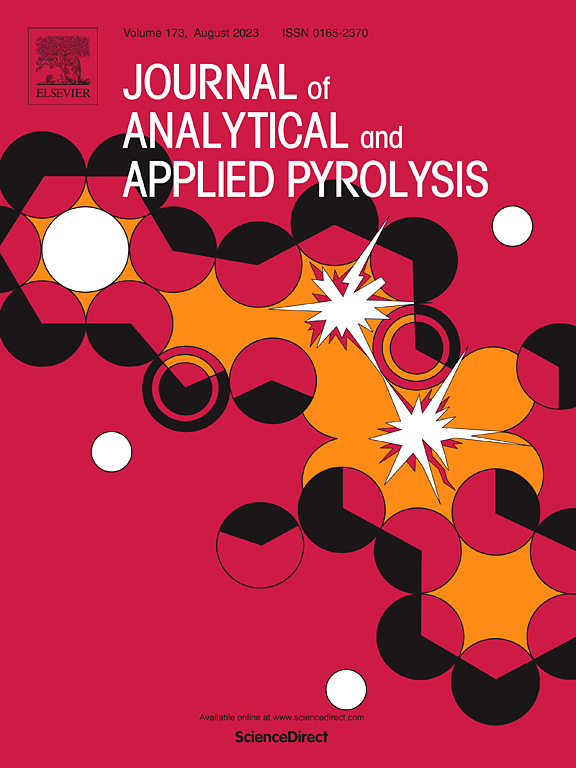Pyrolysis behavior of multi-component photovoltaic modules waste: A coupled STA-FTIR-MCC and modeling approach
IF 5.8
2区 化学
Q1 CHEMISTRY, ANALYTICAL
引用次数: 0
Abstract
With the first million tons of photovoltaics (PV) modules approaching decommissioning, efficient recycling is crucial. Pyrolysis has proven to be an effective method for PV modules recycling. This work details a methodology to characterize the pyrolysis behavior of multi-component PV modules. The mass loss, heat flow, and gaseous products evolution of pyrolyzing PV modules were systematically investigated through simultaneous thermal analysis (STA) and Fourier transform infrared spectroscopy. It was found that the pyrolysis process of PV modules proceeded through four stages, including the melting of polyethylene terephthalate (PET) component, initial thermal decomposition of ethylene-vinyl acetate (EVA) component, progressive pyrolysis of EVA coupled with PET chain scission, and pyrolysis of residual organic matter. The gaseous products were primarily composed of CO2, H2O, and carboxylic acids along with their derivatives. The heat released from the combustion of volatile products was measured using microscale combustion calorimetry (MCC). Through the inverse modeling of STA-MCC results using coupled ThermaKin2Ds modeling framework and Hill-climbing optimization method, the pyrolysis reaction kinetics, heat of reactions, heat capacities of condensed-phase components, and heat of combustion of gaseous products were determined. Subsequently, the pyrolysis model of PV modules was developed, accurately reproducing the experimental pyrolysis reaction rate, heat flow, and heat release rate, with total mass loss deviations < 3 %, total integral heat flow deviations < 10 %, and total heat released deviations < 10 %. This model was further testified against experimental data acquired under varied heating conditions. This work can provide guidance for optimizing pyrolysis recycling of PV modules waste.
多组分光伏组件废弃物的热解行为:STA-FTIR-MCC耦合和建模方法
随着第一批100万吨光伏组件即将退役,有效的回收利用至关重要。热解已被证明是一种有效的光伏组件回收方法。这项工作详细介绍了一种表征多组分光伏组件热解行为的方法。采用同步热分析(STA)和傅里叶变换红外光谱技术对光伏组件热解过程中的质量损失、热流和气体产物演化进行了系统研究。研究发现,光伏组件的热解过程经历了4个阶段,分别是聚对苯二甲酸乙二醇酯(PET)组分的熔融、乙烯-醋酸乙烯酯(EVA)组分的初始热分解、EVA耦合PET链断裂的逐步热解和残余有机物的热解。气态产物主要由CO2、H2O和羧酸及其衍生物组成。采用微尺度燃烧量热法(MCC)测量了挥发性产物燃烧释放的热量。采用耦合thermakin2d建模框架和爬山优化方法对STA-MCC结果进行逆建模,确定热解反应动力学、反应热、凝析相组分热容量和气态产物燃烧热。随后,建立了光伏组件的热解模型,准确再现了实验热解反应速率、热流和放热速率,总质量损失偏差<; 3 %,总积分热流偏差<; 10 %,总放热偏差<; 10 %。在不同加热条件下的实验数据进一步验证了该模型的正确性。该工作可为优化光伏组件废弃物的热解回收提供指导。
本文章由计算机程序翻译,如有差异,请以英文原文为准。
求助全文
约1分钟内获得全文
求助全文
来源期刊
CiteScore
9.10
自引率
11.70%
发文量
340
审稿时长
44 days
期刊介绍:
The Journal of Analytical and Applied Pyrolysis (JAAP) is devoted to the publication of papers dealing with innovative applications of pyrolysis processes, the characterization of products related to pyrolysis reactions, and investigations of reaction mechanism. To be considered by JAAP, a manuscript should present significant progress in these topics. The novelty must be satisfactorily argued in the cover letter. A manuscript with a cover letter to the editor not addressing the novelty is likely to be rejected without review.

 求助内容:
求助内容: 应助结果提醒方式:
应助结果提醒方式:


